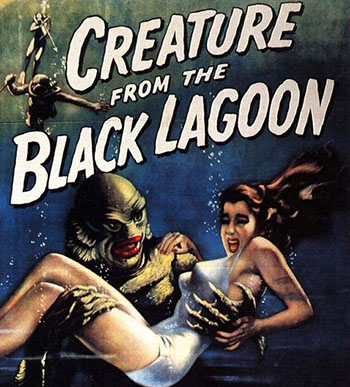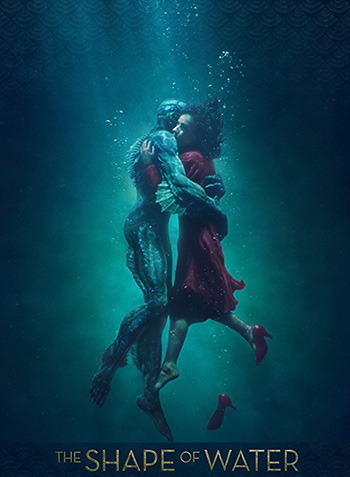Yes, The Shape of Water is worth seeing, if only for the romantic elements and the great performances from Richard Jenkins (especially), Michael Shannon and Sally Hawkins (full frontal, if you’re into that).
And yes, it’s about a mute who falls for a man-fish, so the LGBTQ-slew-of-consonants crowd can add that to their list.
*** SPOILERS!!!!! ****
 It began with Guillermo del Toro watching Creature from the Black Lagoon, and after seeing the beauty of the creature swimming below Julie Adams, felt that the lonely creature should get the girl.
It began with Guillermo del Toro watching Creature from the Black Lagoon, and after seeing the beauty of the creature swimming below Julie Adams, felt that the lonely creature should get the girl.
So, the director who gave us Pan’s Labyrinth, a fairytale too whimsical for some adults and far too gruesome and violent for ALL children gives us…
The Shape of Water
The Shape of Water involves a mute custodian Elisa (Sally Hawkins) who spends her days sleeping, masturbating in the bath, watching musicals with her neighbor Giles (best scenes), and boiling eggs.
At night she cleans up at a government facility, and who has oddly unfettered access to top-secret rooms containing a river god that Strictland (Michael Shannon) dragged up from South America.
Despite the fact that it bit off two of Strictland’s fingers, and despite the management’s fear of Soviet infiltration (too late!), and the 30-ton door with key cards that house it, and the unsecure wading pool with chains about its neck, this custodian feels fine eating her lunch at pool side, and feeding the creature eggs without anyone batting an eye.
Plus, Strictland treats the creature poorly, so he must be set free.
Her neighbor Giles is against the idea initially, but since he’s a homosexual artist, discriminated against at work (rather than some official story) and rejected at the pie cafe, he signs on to rescue Amphibian Man as well.
Plot Corrections
Most elements of this 5 act (Shakespeare) structure are in place, and the pace and tone are perfect for the story. But there are two problems to solve:
First, the opening scene is Elisa’s apartment, underwater. It establishes tone but nothing else. And it’s really expensive to shoot! This scene could be cut without impacting the story in the slightest.
Second, the romantic set up in the beginning of Act 2. Much like Romeo and Juliet, del Toro is creating an intimate connection between Elisa and Amphibian Man, but he’s missing one thing: Amphibian Man’s humanity.
In Black Lagoon, the creature lusts after the girl. Here we see Elisa feeling sorry for Amphibian Man, attracted to it/him in a strange way, but we need a scene that establishes that Amphibian Man is not a wild beast. Otherwise, if we substitute a gorilla or horse, then we have taken an ugly turn into bestiality (though technically, aren’t we already there?).
Anyway, in the scene where Elisa first feeds him the egg — and to correct the odd attraction thing Elisa has — have her working near the tanks, get spooked, and fall into the tank. Suddenly, she thinks she’s going to be eaten alive by the monster, gets her clothing caught on a pipe or something so she’s terrified and the audience believes they’re about to see a piranha feeding frenzy of blood as she goes down… That’s when Amphibian Man frees her and places her safely back at pool side.
That makes the attraction EARNED. He’s worthy of her affections by performing a kind act that shows he’s a creature of unrequited love, as she is.
The Shape of Water Values
 We have a lovelorn Elisa and lovelorn gay Giles on one side of the equation, willing to risk everything for love. On the other, we have Strictland, an angry, duty-bound functionary, cruel, cold, and relentless.
We have a lovelorn Elisa and lovelorn gay Giles on one side of the equation, willing to risk everything for love. On the other, we have Strictland, an angry, duty-bound functionary, cruel, cold, and relentless.
Sounds like we’ve got a “love vs duty” set up, doesn’t it?
Well, we don’t. Elisa hasn’t internalized that tension. She and her team aren’t wrestling with this “love vs duty” at all. She has only what Christians refer to as a “God-shaped hole” in her life, and the river god is going to fill it.
For example, if she were married to Giles, and they had kids and civic responsibilities, then throwing all that overboard to rescue this miracle of nature would be “compassion conquering duty.”
But Elisa’s values is “love conquering all” where “all” isn’t specified. Is it convention, bucking the conformity of hetero-society? Propriety? Sanity?
She didn’t seem tragically unhappy beforehand either, so it’s not like she’s overcoming a list of bad boyfriends or her family’s expectations.
Because the story’s values are not clear, we’re left with perhaps Gore Vidal’s quote, taken as a slogan for the homosexual community: “The important thing is not the object of love, but the emotion itself.”
The problem is, while images create emotion, great stories are built on values in contention. What is the moral decision for Elisa NOT to rescue Amphibian Man? That’s missing.
The Shape of Strictland
Just as Elisa plays values tennis without a net, so Strictland becomes unrelatable. He’s… you know, strict. And he’s mean, and likes pain or something.
He also has a really normal, though stifled suburban family with sex-starved housewife — you know, unlike those colorful city-dwelling dreamers with their green jello paintings and musicals.
That is, Strictland is not merely a caricature of a Christian conservative or military or government functionary, he represents all of bigoted, patriarchal, science-rejecting, heteronormative America, which is unable to breathe in the full beauty and miracles of love to be found if we only just risked enough to love and bone the creature from the black lagoon.
If it’s starting to feel like this story is more political than at first blush, it is.
If it sounds like I mostly enjoyed a well crafted film that upon further inspection insults 95% of America’s citizens with its theme, you’re also right.
But if you can swallow the deconstruction of 1950s America, and believe in Amphibian Man as Gaia deity, then you can accept Elisa’s cut vocal cords becoming gills as the two swim too eternal freedom in the murky Baltimore river.
Let’s hope they’ll find an underground river to the Amazon in the sequel.
